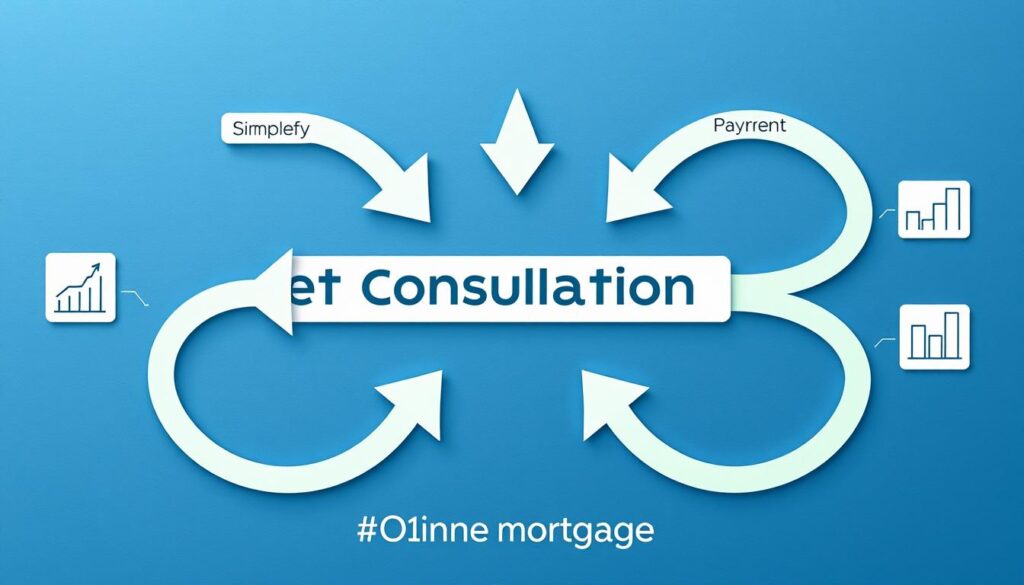As seasoned experts in finance, we understand that navigating the world of mortgage options can be a daunting task, especially for the first-time homebuyer. Finding that sweet spot where monthly payments, interest rates, and the duration of the loan align with your financial goals isn’t always straightforward. That’s why we’re committed to guiding you through the variety of Loan Term Options available, tailoring our expertise to fit your unique situation whether you’re looking to plant roots with a new home or aiming to refinance and optimize your current mortgage.
We pride ourselves on offering mortgage options that cater to a diverse range of needs. It’s essential to sift through conventional mortgages, government-aided programs, and specialty loans designed for particular demographics or financial conditions. Our insights focus on demystifying the intricacies of loan terms, educating you on how they can influence down payments and the total cost over a loan’s lifespan. From crunching the numbers on interest rates to projecting long-term savings, our aim is to empower you to make informed decisions that pave the way to financial stability.
Key Takeaways
- Comprehend the wide array of Loan Term Options and their implications on your finances.
- Gain insight into mortgage options that cater to both first-time homebuyers and seasoned investors.
- Learn how to balance monthly payments, interest rates, and loan duration to meet your financial goals.
- Understand the nuances between different loans, including conventional and government-backed mortgages.
- Expert advice on how to effectively navigate loan terms during both the home purchase and refinance processes.
Understanding Different Types of Loans
When embarking on the journey to secure financing, it’s crucial to understand the different types of loans available. Each loan type is designed to meet specific financial needs and situations, making it imperative for borrowers to choose wisely to align with their financial goals and circumstances.
Conventional Loans: The Basics
Conventional loans are a popular choice among borrowers due to their flexibility and the potential for lower costs over time. Unlike government loans, these are not backed by a government entity, which often translates into more stringent credit and income requirements. Conventional loans are favored for their variety of term lengths and competitive interest rates.
Government-Backed Loans and Their Advantages
Government loans offer distinct benefits that are particularly appealing to first-time homebuyers and those who might not qualify for conventional loans. Programs like FHA loans, VA loans, and USDA loans provide lower down payment options and more flexible eligibility criteria. FHA loans are ideal for those with lower credit scores, VA loans offer excellent terms for veterans and active military, while USDA loans are perfect for buyers in rural areas seeking 100% financing.
Special Program Loans for Targeted Needs
Special program loans are tailored to assist specific groups of buyers such as first-time homebuyers, low-income families, or those purchasing homes in targeted redevelopment areas. These programs often combine favorable loan terms with benefits like down payment assistance, which can be critical for those who might otherwise be unable to purchase a home.
| Loan Type | Typical Eligibility | Common Benefits |
|---|---|---|
| Conventional Loans | Good credit, stable income | Lower interest rates, various term options |
| FHA Loans | Lower credit scores | Low down payments, easier qualification |
| VA Loans | Veterans, active military | No down payment, no private mortgage insurance |
| USDA Loans | Buyers in rural areas | No down payment, below-market interest rates |
| Special Program Loans | Varies by program | Down payment assistance, favorable terms |
Choosing the Right Loan Term for Your Mortgage
When embarking on the journey of homeownership, selecting the right loan term is crucial for balancing your financial stability with your long-term goals. The duration of your loan term significantly affects your repayment schedule, the amount of mortgage insurance payable, and the size of the down payment required. It requires a delicate balance between current financial capabilities and future financial health.
Benefits of Shorter Loan Terms
Opting for a shorter loan term can yield substantial savings on interest payments, despite the higher monthly outlay. Accelerated repayment schedules contribute to building equity in your home faster, which can be advantageous if refinancing or selling your home are considered in the future. These shorter terms are often accompanied by lower interest rates, which enhance the overall savings.
Comparing Long vs Short Mortgage Terms
Understanding the trade-offs between long and short mortgage terms is essential for making a well-informed decision. While longer loan terms offer the benefit of lower monthly payments, they typically incur higher interest costs over the duration of the loan. On the other hand, shorter terms, although demanding a higher monthly commitment, minimize the total interest paid and expedite equity growth.
| Loan Term | Monthly Payment | Total Interest Paid |
|---|---|---|
| 15 Years | Higher | Lower |
| 30 Years | Lower | Higher |
Choosing the right loan term involves considering how much you can afford to put down upfront and the amount you are prepared to pay monthly. Discussing with lending professionals and reviewing different repayment schedules can aid in identifying a loan term that aligns most effectively with your financial strategy. Remember, the right decision balances immediate affordability and long-term financial flexibility.
Fixed-Rate vs. Adjustable-Rate Mortgages
When exploring housing finance options, understanding the key differences between fixed-rate loans and adjustable-rate mortgages is crucial for making an informed decision that aligns with your financial goals. Here, we delve into the stability offered by fixed-rate mortgages and the potential for cost savings with adjustable-rate mortgages.
Stability of Fixed-Rate Mortgages
Fixed-rate loans are preferred for their predictability and consistency. These loans lock in an interest rate that remains constant throughout the life of the loan, ensuring steady monthly payments. This feature makes budget planning more straightforward and guards against the unpredictability of fluctuating interest rates. By conforming to mortgage regulations and providing detailed loan estimates, lenders ensure borrowers are well-informed about their financial commitments.
Potential Savings with Adjustable-Rate Mortgages
Adjustable-rate mortgages (ARMs), on the other hand, offer initially lower rates compared to fixed-rate loans, which could lead to significant savings in the early years of a mortgage. The rate, however, is adjusted periodically based on the prevailing market conditions, which can either increase or decrease your monthly payments.
| Loan Type | Interest Rate Type | Initial Rate | Rate Adjustment | Cap Structure |
|---|---|---|---|---|
| Fixed-Rate Mortgage | Fixed | Higher Initial Rate | N/A | N/A |
| Adjustable-Rate Mortgage | Variable | Lower Initial Rate | Periodic Adjustment | Presence of Rate Caps |
Understanding these attributes is essential in navigating the complexities of mortgage options. Ensuring compliance with current mortgage regulations and obtaining accurate loan estimates can mitigate potential risks associated with interest rate adjustments in adjustable-rate mortgages.

The Impact of Interest Rates on Loan Terms
When we consider the dynamics of securing a mortgage, understanding the influence of Interest Rates is crucial. These rates dictate not only your monthly payments but also the total cost of your loan over its lifetime. Let’s explore how this factor impacts your decision-making process, especially when mulling over options like discount points and lender credits.
Typically, potential homeowners are faced with a decision: should they pay discount points upfront to reduce their interest rate, or accept lender credits to lower closing costs? This choice depends heavily on how long you plan to hold onto your current loan, influencing potential savings or costs long-term.
A loan estimate plays a pivotal role here, providing a detailed preview of the costs associated with your potential mortgage. By understanding these details, you can better navigate the trade-offs between immediate expenses and long-term benefits. To illustrate, let’s look at how discount points and lender credits might affect your loan’s terms.
| Option | Immediate Cost | Long-term Savings | Best For |
|---|---|---|---|
| Discount Points | Higher upfront | Potentially significant over time | Borrowers planning to keep the loan long-term |
| Lender Credits | None upfront | Less total savings | Borrowers seeking to minimize initial expenses |
This table provides a comparative look at the implications of choosing between paying upfront to lower future costs or optimizing initial savings. The right strategy depends largely on individual financial scenarios and how the market’s Interest Rates might fluctuate during your loan term. As always, a comprehensive loan estimate should guide these decisions to align with your long-term financial goals and current economic realities.
Navigating Amortization Periods
Understanding the amortization period of a loan is essential for managing both the entire loan cost and interest payments effectively. This period determines the timeframe over which the loan balance is to be paid off and significantly impacts your financial planning. Here, we explore the impact of different amortization periods on your finances and offer strategies to align them with your financial goals.
An amortization period not only affects how long you’ll be in debt but also the amount of interest you’ll pay over the life of the loan. Longer periods mean smaller monthly payments, which might be easier on your budget, but they also accrue more in interest payments, increasing the entire loan cost.
- An extended amortization period reduces monthly payments but increases the total interest.
- A shorter amortization period raises monthly payments but decreases the total interest paid.
In financial planning, understanding the balance and trade-offs between these elements is crucial. Setting a proper amortization period can help manage monthly expenses while considering long-term financial implications.
| Amortization Period | Monthly Payment | Total Interest Paid | Total Loan Cost |
|---|---|---|---|
| 15 years | $1,200 | $60,000 | $216,000 |
| 30 years | $800 | $120,000 | $288,000 |
The table above illustrates how extending the amortization period from 15 to 30 years can decrease monthly payments but significantly increase both total interest and the entire loan cost. This is crucial information for anyone trying to find the right balance between monthly payments and total loan expense.
Loan Term Options for Personal Loans
When exploring personal loans, understanding the variety of loan term options available is crucial for effective financial planning. The term length of a loan can significantly influence your monthly budget, the total interest paid, and the overall credit score impact. Whether you opt for short-term or long-term personal loans, each choice has its strategic advantages and considerations.
Short-Term Personal Loans: Pros and Cons
Short-term personal loans are often selected for their ability to provide quick financial relief without a prolonged commitment. These loans are typically paid off within a year and are advantageous for those with sufficient income to handle higher monthly payments. Here’s a quick overview:
- Pros: Less accumulated interest, shorter debt period, quicker credit score recovery post-repayment.
- Cons: Higher monthly payments can strain your budget if not carefully planned.
Long-Term Loans: Understanding the Longer Commitment
On the other end of the spectrum, long-term personal loans spread out repayment over several years, reducing monthly payments but increasing the total interest over time. Suitable for substantial sums borrowed for major expenses or significant financial projects, here are critical points to consider:
- Pros: Smaller monthly payments are easier on your budget, better manageability with other financial commitments.
- Cons: More interest paid over time, longer burden of debt.
Effective financial planning with personal loans involves forecasting monthly budgets, future income, and potential life changes. Whether you’re looking at installment loans for immediate large purchases or aiming for better credit score management, aligning your loan term with your financial goals and capacities is integral.
How Early Repayment Affects Your Loan
Deciding to pay off your loan early can significantly alter the course of your financial planning. Understanding both the benefits and potential drawbacks of early repayment is crucial for informed decision-making.
Advantages of Paying Off Loans Early
Paying off loans before their scheduled end date can lead to substantial savings on interest, which reduces the overall cost of borrowing. Besides financial savings, early debt payoff can also relieve psychological stress, providing a sense of freedom and financial liberation. This strategy empowers many individuals to reallocate resources towards other financial goals such as investments or saving for retirement.
Considering Prepayment Penalties
While the benefits of early repayment are clear, it’s essential to consider possible prepayment penalties that lenders might impose. These penalties are often instituted to compensate for the interest income lenders lose when loans are paid off prematurely. Before making an extra payment, it is advisable to review your loan agreement for any clauses related to prepayment penalties to ensure that the cost does not outweigh the benefits.
To effectively evaluate whether early repayment is a favorable option, weigh the potential savings against any applicable prepayment penalties. Employing a methodical approach will help ensure that your decision to pay off debts early aligns with your overall financial strategy and objectives.
Strategies for Refinancing to Optimize Loan Terms
Refinancing can be a powerful strategy to enhance your financial flexibility. By exploring different loan options and securing lower interest rates, you may significantly reduce your monthly payments or even shorten the loan term. It’s important to consider various factors to ensure that refinancing will serve your financial goals effectively.
Understanding the right time to refinance is crucial. It generally revolves around favorable economic conditions that allow for lower interest rates. Additionally, an improved credit score can help secure a better rate, ultimately making refinancing a more attractive option.
- Assess your current financial situation.
- Compare available refinancing options.
- Calculate potential savings from lower interest rates.
- Consider the total cost of refinancing.
| Aspect | Before Refinancing | After Refinancing |
|---|---|---|
| Interest Rate | 4.5% | 3.5% |
| Monthly Payment | $1,200 | $1,050 |
| Loan Term | 30 years | 25 years |
While considering refinancing, it’s essential to take into account the upfront costs, such as closing fees, and evaluate if the long-term savings justify these expenses. For homeowners planning to stay in their homes for many years, refinancing could offer significant financial benefits.
To conclude, refinancing offers an array of benefits, including lower interest rates and adaptable loan options that cater to changing personal financial conditions. By meticulously analyzing your financial situation and current market conditions, you can determine if refinancing is the right move for you.
Debt Consolidation: Combining Loans for Simplified Repayment
Debt consolidation emerges as a powerful tool to enhance loan management by transforming multiple debt streams into a single, manageable account. Through consolidating debts, individuals gain access to a simplified repayment schedule, potentially reducing the overall monthly payments and streamlining the repayment process. This method directly addresses the complexities associated with managing multiple payments, interest rates, and due dates, providing a structured approach to financial stability.

One pivotal advantage of debt consolidation is its capacity to potentially lower the cumulative amount of interest paid over the lifetime of the loan. By consolidating high-interest debts, especially from credit cards, into a single loan with a lower interest rate, the total cost of debt can be significantly reduced. This economically efficient strategy not only simplifies the repayment schedule but also contributes positively to overall loan management.
| Debt Type | Interest Rate Before Consolidation | Interest Rate After Consolidation | Monthly Payment Before | Monthly Payment After |
|---|---|---|---|---|
| Credit Card | 22% | 15% | $250 | $200 |
| Personal Loan | 12% | 8% | $150 | $120 |
| Auto Loan | 8% | 6% | $300 | $280 |
In conclusion, embracing debt consolidation as a maneuver to control and diminish the complications of multiple loans can lead to a more predictable financial environment. It enables a singular focus for repayment and aligns with an individual’s pursuit of a debt-free lifestyle in a structured and strategic manner. It invites a breath of relief for those juggling various debt obligations and offers a path towards financial liberation and improved loan management.
Conclusion
In our journey to demystify the myriad of loan term options available, we’ve navigated through various mortgage solutions and weighed their implications for comprehensive financial planning. The pursuit of the ideal home financing plan necessitates a balanced assessment of fixed-rate and adjustable-rate mortgages, wherein each offers distinct advantages tailored to different financial scenarios. With careful consideration and accurate loan estimates, anyone can optimize their choice to support both present budgetary constraints and future fiscal stability.
We understand that diving deep into the details of mortgage terms, amortization schedules, and interest rates can be daunting. Yet, it’s this meticulous approach that arms borrowers with the foresight to make enlightened decisions. From seizing control over monthly payments to devising strategies for potential early repayments or even refinancing opportunities, the crux of financial wisdom lies in aligning one’s choices with their long-term economic aspirations. Whether the goal is to reduce overall loan costs or to manage cash flow, clarity in these choices is paramount.
Ultimately, our cumulative insights serve as a roadmap for those embarking on the often complex path to homeownership and loan management. We must underscore the importance of personalized advice, as each financial situation is unique. Loan term options are not one-size-fits-all; they shape the structure of one’s finances for years to come. By equipping ourselves with knowledge and understanding the nuances of various mortgage solutions, we set a strong foundation for financial health and work towards realizing the dream of homeownership with confidence and clarity.







